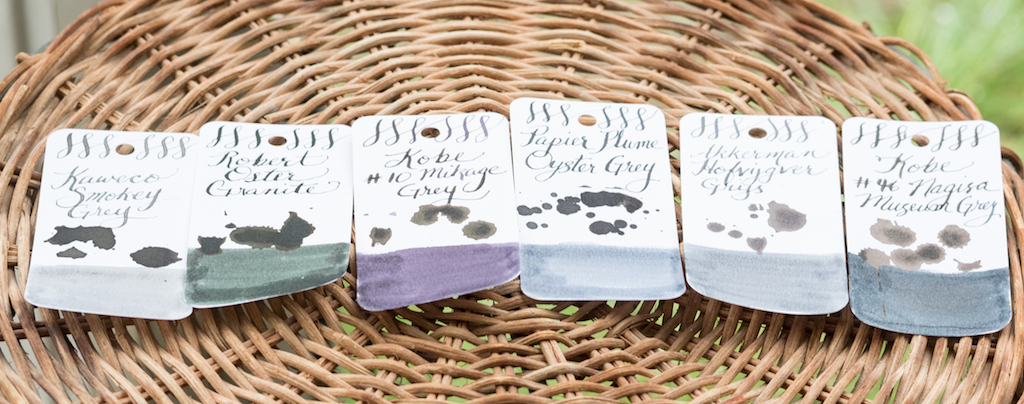(Susan M. Pigott is a fountain pen collector, pen and paperholic, photographer, and professor. You can find more from Susan on her blog Scribalishess.)
A few weeks ago I reviewed Kaweco Smokey Grey ink. Unfortunately, I was unimpressed with that ink, but I needed a matchy ink to go with my lovely Montblance Alexandre Dumas fountain pen. So, I bought some grey ink samples from Vanness Pens and decided to compare them.
The six inks I compared are Kaweco Smokey Grey, Robert Oster Graphite, Kobe #10 Mikage Grey, Papier Plume Oyster Grey, Akkerman #29 Hofvijver Grijs, and Kobe #46 Nagisa Museum Grey.
In the comparison above, you can see that I wound up with quite a variety of greys, ranging from the very light Kaweco to the almost black Nagisa Museum Grey.
The chromatography on each ink reveals some interesting characteristics.
L to R: Kaweco Smokey Grey, Robert Oster Graphite, Kobe Mikage Grey, Papier Plume Oyster Grey, Akkerman Hofvijver Grijs, and Kobe Nagisa Museum Grey
Kaweco Smokey Grey has virtually no color range, varying slightly from grey to light lavender. Robert Oster Graphite is the most spectacular of the bunch at least in terms of chromatography, with lots of magenta and blue. Kobe Mikage contains mostly lavender and a little bit of blue. Papier Plume Oyster Grey contains blue and magenta tones. Akkerman Grijs is, perhaps, the truest grey, revealing no other colors. Kobe Nagisa Museum Grey is the darkest of all, and like the Akkerman, it demonstrates virtually no color variation.
Close ups of the ink swatches show what each ink looks like using a Brause 361 Steno Blue Pumpkin Calligraphy Pen Nib along with splotches and swabs.
Kaweco Smokey Grey is quite light in the swab, but with the wet dip nib, it writes more like a dark grey.
Robert Oster Graphite, despite its colorful chromatography, is a dark grey both in the swab and with the pen. The ink splats show a tiny bit of sheen, but unfortunately it’s been raining in Abilene all week, and I couldn’t get pictures with sunlight displaying the sheen in all its glory.
Kobe Mikage Grey, in my opinion, is the most intriguing shade of grey. In the swab, the writing, and the splats its purple hue is quite striking.
Papier Plume is a really nice blue-grey as revealed in the swab. With the pen, it appears as a dark grey with some blue sheen.
Akkerman Grijs is definitely the truest grey. The swab shows that it’s a flat color with little variation.
Kobe Nagisa Museum Grey is very close to black with some nice sheen.
I was really pleased with the wide variety of grey shades in these samples. I’ve pretty much written off Kaweco Smokey Grey as being too light and uninteresting for my use. If I wanted a true grey, I would choose the Akkerman. I found Kobe Nagisa to be too close to Iroshizuku Take-Sumi which I already own. Although Robert Oster inks are usually among my top picks, I didn’t much like Graphite, even though the chromatography made the ink look really interesting. So, of the six shades of grey, my two favorites are Papier Plume Oyster with its beautiful blue-grey tones and nice shading and Kobe #10 Mikage Grey with its deep purple-grey hue. It also shades quite well and has some sheen.
Currently my Montblanc Alexandre Dumas is inked with Kobe Mikage. When I run out of that, I’ll put the Papier Plume in the pen and make my final decision about which ink I’ll buy.
You can purchase a 30ml bottle of Kaweco Smokey Grey from JetPens for $13.50. All the other inks are available from Vanness Pens. Robert Oster Graphite is $17.00 for 50ml. Kobe #10 Mikage Grey and Kobe #46 Nagisa Museum Grey are $30.00 for 50ml. Papier Plume Oyster Grey is $7.00 for 30ml. And Akkerman Hofjijver Grijs is $28.00 for 60ml.
(I purchased the ink samples above with my own funds from Vanness Pens.)
Enjoy reading The Pen Addict? Then consider becoming a member to receive additional weekly content, giveaways, and discounts in The Pen Addict shop. Plus, you support me and the site directly, which I am very grateful.
Membership starts at just $5/month, with a discounted annual option available. To find out more about membership click here and join us!




























